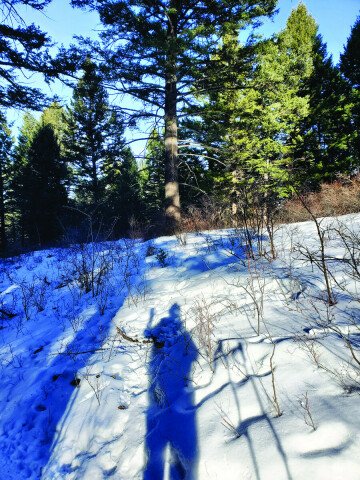Balancing the Sun This Equinox
Kelly Nicholson | Tuesday Mar. 1st, 2022

Every year, the depths of winter shroud us in darkness and bitter cold. We hunker down and try our best to be content, but as the inevitable daydreams of warmer weather and longer days begin to creep in, seeds of restlessness sow themselves in our minds and with each new garden catalog delivered, our attempts at patience become harder to sustain.
For those of us forced to spend our winter daily light allotment working in artificially illuminated buildings, the feelings of eternal darkness are amplified. For days on end, we wake up before the sunrise, bundle ourselves against the early morning cold, drive to work, sell our labor for eight hours, redon the warm layers, and motor home after sunset. It’s an emotionally defeating cycle, and with Montana’s notoriously long winters, it can be a challenge to stay optimistic.
When the spring equinox, also called the vernal equinox, arrives in late March, we find that we have been mentally planning our garden beds and camping trips for weeks, and know that we still have a long way to go before we’re floating down an ice-free river and attending an outdoor concert in shorts. However, this biannual astronomical event is a herald of new beginnings, and it promises that our frigid wait will be worth it.
Earth’s seasons are caused by its slight tilt and steady orbit: when the north pole leans towards the Sun, it is summer here in the northern hemisphere and winter in the southern hemisphere; when the north pole shies away from the Sun, the seasons reverse. Equinoxes occur when the Earth’s axis is pointed neither toward nor away from the Sun and the center of the Sun is in direct alignment with the Earth’s equator, resulting in a day of nearly equal amounts of light and dark for the entire planet. Taking place once in the spring and once in the fall, these events of balanced light last for only a moment in time. This year’s spring equinox will occur on March 20th at 9:33 am MST.
Humans have observed and documented the Sun’s path throughout the year in a variety of ways. One of the most well-known is the prehistoric monument known as Stonehenge. Located in southern England, this mysterious circle of stones was constructed thousands of years ago and is believed to have been built as an astronomical calendar. Today, Druids and Pagans gather at Stonehenge every vernal equinox to mark the beginning of spring.
Back on our side of the pond in Chaco Canyon, New Mexico, remnants of an ancient Puebloan culture still stand. Among the ruins is one of the most famous petroglyphs in the southwest —the Sun Dagger, which marks solar events on a spiral carved into rock slabs. Recognizing equinoxes and other solar events was an important survival tool for many Native American tribes. Their awareness of seasonal change helped them mark migration periods, locations of animals for hunting, and plant dormancy.
In Mexico, we can visit Mayan pyramids that were built to signal the start of spring, among many other functions. The Mayans had the most advanced astronomical understanding of their time. The descent of the “feathered serpent” Kulkulkan’s shadow from his temple in Chichen Itza, Mexico was an important marker for both equinoxes and corresponded with the planting and harvesting of maize.
Equinoxes signal a shift in the seasons and are celebrated across the globe. The spring equinox is a symbol for rebirth and renewal in many diverse cultures. In the United States, thoughts of spring induce images of flowers, rabbits, and colored eggs, the universal symbol of fertility. Eggs are important components in many spring celebrations. For example, in Bosnia, Cimburijada (also known as the “Festival of Scrambled Eggs”) marks this season change with thousands of people eating scrambled eggs together. There is also the ancient Chinese practice of standing eggs on end to physically represent the balance of day and night. This activity was adopted by Americans in the late 1940’s and egg-balancing ceremonies promoting world peace and international harmony are still held in New York every year.
It’s no coincidence that thrift stores see an influx of donations every spring. The tradition of “spring cleaning” is symbolic as well as functional, and there are many different origins of this practice. The spring equinox signals the beginning of the Persian new year, known as Nowruz. Rooted in Iranian tradition, this thirteen-day holiday is preceded by a “shaking of the house,” in which everything in the home is thoroughly cleaned before celebrations begin. There is also the Jewish practice of deep cleaning before Passover and the Catholic tradition of cleaning the altar before Good Friday. For practical purposes, warmer temperatures in March allow for the opening of windows after a long winter for fresh air to circulate into the home once again.
There are many, many other ways to celebrate this pivotal, biannual solar event. Some are a bit weird, like the burning of worn-out socks in Maryland or participating in the world’s biggest water fight in Thailand, while others are serene and productive, like repairing broken items to renew their usefulness, or drinking dandelion and burdock cordials for good health. Creating your own traditions could be an excellent way to incorporate seasonal changes into your life; there is no wrong way to celebrate!
The next time your morning alarm goes off, peek out your window. Whatever you see, take it all in, because everything will soon change. It’s the nature of things. Remember that all of life is cyclical, even the water circulating through your coffee maker. Make notes in seed catalogs, apply for river permits, and buy your music festival passes. The spring equinox will deliver a moment of balance before plunging us back into the light and, after a long winter, we will all be ready for it.
| Tweet |
